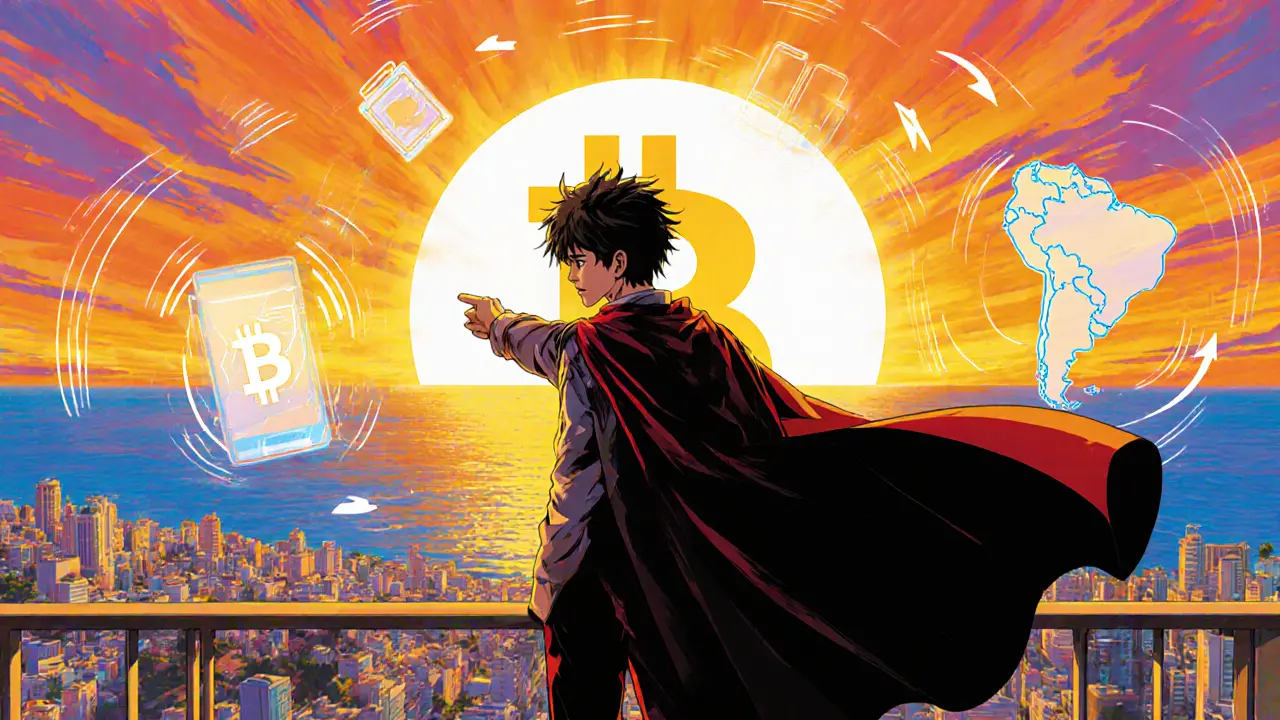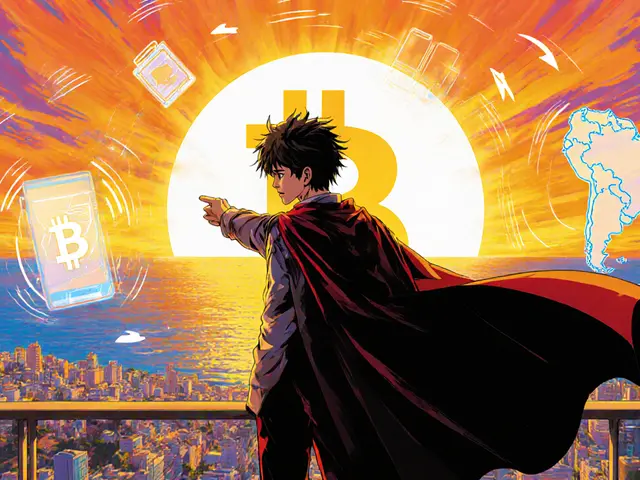El Salvador Bitcoin Adoption Impact Calculator
Enter values and click Calculate to see impact analysis
| Aspect | Bitcoin Legal Tender | Traditional Fiat System |
|---|---|---|
| Currency Control | Decentralized, market-driven price | Central bank sets policy, stable pricing |
| Remittance Cost | Potentially lower with Bitcoin | Higher fees due to intermediaries |
| Financial Inclusion | Mobile-based access for unbanked | Requires traditional banking infrastructure |
| Volatility Risk | High price fluctuations | Stable and predictable |
| Regulatory Framework | Emerging and evolving | Established legal protections |
When El Salvador a Central American nation of about 6.3million people announced in September2021 that it would make Bitcoin the world’s first decentralized digital currency legal tender, the move sparked a worldwide debate about the role of crypto in national economies.
Key Takeaways
- ElSalvador’s Bitcoin plan aimed to broaden financial inclusion, lower remittance fees, and attract tech investment.
- The core tools were the state‑run Chivo Wallet a mobile app for buying, sending and spending Bitcoin, a strategic reserve of over 6,100 BTC, and ambitious projects like Volcano Bonds and Bitcoin City.
- Merchant adoption grew fast (over 80% of small businesses accepted Bitcoin by 2025) but actual usage stayed low - less than 1% of remittances used the crypto.
- Price volatility and pressure from the International Monetary Fund (IMF) forced the government to drop Bitcoin’s legal‑tender status in January2025.
- Going forward, ElSalvador is shifting to a hybrid model that supports private‑sector crypto while avoiding macro‑economic risks.
Why Bitcoin? The Economic Context
About 70% of Salvadorians lacked access to traditional banking services, and remittances accounted for roughly 20% of GDP. Conventional banks charged 5‑10% in fees, eroding household income. President NayibBukele the 43‑year‑old leader who took office in 2019 argued that a borderless, peer‑to‑peer currency could bypass intermediaries, cut fees, and bring unbanked citizens into the formal economy.
Bitcoin also offered a way to diversify away from the U.S. dollar, which had been the official currency since 2001. By issuing a sovereign digital asset, the government hoped to showcase itself as a tech‑forward hub and lure foreign investors looking for regulatory sandbox environments.
Core Components of the Strategy
The government built a multi‑layered ecosystem:
- Chivo Wallet - Launched in October2021, the app let anyone download a free digital wallet, receive a $30‑USD sign‑up bonus, and convert between Bitcoin and dollars instantly. The wallet integrated with point‑of‑sale terminals, allowing merchants to scan QR codes for payments.
- Strategic Bitcoin Reserve Fund - Managed by the Ministry of Finance, the fund accumulated Bitcoin through purchases from the open market. By March2025 it held 6,102BTC, roughly US$500million at prevailing prices.
- Volcano Bonds - Proposed sovereign bonds secured by the Bitcoin reserve. The idea was to issue debt that would pay investors in Bitcoin, turning the reserve into a funding lever for infrastructure projects.
- Bitcoin City - A planned high‑altitude metropolis powered by geothermal energy from the nearby volcano. The city was to offer zero‑tax incentives to crypto firms, creating a tax‑free zone for blockchain startups.
Each pillar was marketed as a revenue‑generating engine, but the rollout faced uneven execution.
Adoption Results: Merchant Uptake vs. Consumer Use
By mid‑2023, surveys showed that 65% of small retailers could accept Bitcoin via the Chivo terminal, climbing to 82% by early2025. The public‑sector followed suit, with the Ministry of Education paying teachers’ bonuses in Bitcoin for a brief trial.
Despite the high percentage of businesses ready to take crypto, actual transaction volume remained tiny. The World Bank estimated that only about 1% of the $3billion annual remittance flow passed through the Bitcoin channel. Most Salvadorians still preferred the traditional dollar route, citing risk aversion and a lack of clear guidance on tax reporting.
Interestingly, a 2022 study found that more adults owned a Lightning‑network wallet than a conventional bank account, suggesting that the technical infrastructure succeeded even if user confidence lagged behind.

Volatility, Treasury Management, and IMF Pressure
Bitcoin’s price swings made fiscal planning a nightmare. When BTC fell 30% in late2022, the reserve’s market value dropped by $150million overnight, forcing the finance ministry to sell assets to meet budget commitments. The IMF, which was negotiating a $1.4billion assistance package, repeatedly warned that the crypto experiment jeopardized macro‑economic stability.
By early2024, the IMF conditioned its loan on the removal of Bitcoin’s legal‑tender status. The organization argued that the government’s balance sheet was exposed to market risk, and that the “mandatory” acceptance rule created regulatory uncertainty for businesses.
Faced with the threat of losing crucial financing, the Bukele administration softened its stance, making Bitcoin optional for private actors in mid‑2024 and eventually repealing the legal‑tender law in January2025.
Policy Shift in 2025: From Full Adoption to a Hybrid Model
The January2025 decree revoked Bitcoin’s status as legal tender but kept the Chivo Wallet operational for voluntary transactions. The Strategic Reserve continued to grow; a March2025 purchase added 8BTC, pushing the total to over 6,100 coins.
ElSalvador repositioned itself as a “crypto‑friendly” jurisdiction rather than a fully Bitcoin‑based economy. The country hosted the PLANB Forum2025, the largest crypto‑assets conference in Central America, signaling an ongoing commitment to blockchain innovation despite the regulatory rollback.
Analysts now view the nation’s approach as a case study in “managed hybridity”: the state maintains a supportive environment for private‑sector crypto activity while avoiding the sovereign‑risk exposure that comes with mandating a volatile digital asset.
Lessons for Other Nations
If another government is contemplating a similar path, consider the following checklist:
- Clear fiscal safeguards: Establish a reserve‑management protocol that caps exposure to price swings (e.g., using stablecoins or hedging instruments).
- Regulatory clarity: Provide transparent tax guidance and consumer‑protection rules before demanding merchant adoption.
- Education first: Invest in nationwide crypto‑literacy programs that go beyond a single app tutorial.
- Infrastructure partnership: Work with telecoms and fintechs to ensure reliable internet access in rural areas.
- International coordination: Anticipate concerns from bodies like the IMF or World Bank and design a phased rollout that can be adjusted without jeopardizing broader aid.
Future Outlook for ElSalvador
Looking ahead, the country aims to leverage its existing reserve as a “digital asset corridor” for regional fintech firms. By offering a sandbox where developers can test Lightning‑network applications, ElSalvador hopes to attract venture capital without committing national policy to a single cryptocurrency.
The Bitcoin City project remains on hold, but the government is still scouting geothermal sites to power data centers-a move that could make the nation a low‑cost hub for mining and AI workloads.
In short, while the original legal‑tender experiment did not deliver the promised macro‑economic boost, the infrastructure and regulatory experience gained may still pay dividends as the global crypto ecosystem matures.
| Aspect | Bitcoin Legal Tender (2021‑2025) | Traditional Fiat System |
|---|---|---|
| Currency Control | Decentralized, market‑driven price | Central bank sets policy, stable pricing |
| Remittance Cost | Potentially <1% with Lightning, but actual usage low | Typical 5‑10% fees via intermediaries |
| Fiscal Risk | High - reserve value swings with BTC price | Low - predictable sovereign debt |
| International Acceptance | Limited - IMF & World Bank opposition | Broad - universally recognized |
| Infrastructure Needs | Digital wallets, PoS terminals, broadband | Bank branches, ATMs, legacy payment rails |
Frequently Asked Questions
Is Bitcoin still legal tender in ElSalvador?
No. The legal‑tender law was repealed in January2025, but Bitcoin can still be used voluntarily through the Chivo Wallet and private merchants.
How much Bitcoin does the government actually hold?
By March2025 the Strategic Bitcoin Reserve Fund contained 6,102BTC, worth roughly US$500million at the time.
Did the Chivo Wallet succeed in boosting financial inclusion?
The wallet installed over a million users, yet only about 1% of remittances passed through it, indicating limited impact on everyday financial behavior.
What were the main criticisms from the IMF?
The IMF warned that mandatory Bitcoin acceptance exposed the treasury to volatile market risk, undermined fiscal stability, and jeopardized the country’s eligibility for a $1.4billion assistance package.
Can other countries learn from ElSalvador’s experiment?
Yes. The key takeaways are to limit sovereign exposure to crypto price swings, ensure regulatory clarity before mandating use, and pair any blockchain rollout with robust education and infrastructure.
The saga of El Salvador Bitcoin adoption shows that bold policy can spark innovation, but without safeguards it may also create new risks. As the crypto world matures, the country’s hybrid approach could become a template for balancing freedom and fiscal responsibility.









Comments (21)
vincent gaytano
March 29, 2025 AT 23:55 PMLooks like the IMF secretly funds every crypto crisis just to keep us dependent on their sugar‑coated loans.
Dyeshanae Navarro
April 1, 2025 AT 09:19 AMWhen we imagine a future where money is truly borderless, we must also nurture the trust that binds communities together.
Matt Potter
April 3, 2025 AT 17:43 PMEl Salvador showed the world that daring experiments can spark real change, and we should double‑down on such bold moves!
Marli Ramos
April 6, 2025 AT 02:07 AMlol the whole thing feels like a tech buzzword party 😂
Kathryn Moore
April 8, 2025 AT 10:31 AMBitcoin reserves peaked at 6,100 BTC, roughly $500 M at March 2025 prices.
Christine Wray
April 10, 2025 AT 18:55 PMWhile concerns about external influence are understandable, the experiment also offered valuable lessons on digital inclusion.
roshan nair
April 13, 2025 AT 03:19 AMThe Chivo Wallet rollout demonstrated that mobile penetration can be leveraged for financial services, even in rural areas. However, the $30 sign‑up bonus created a short‑term incentive without fostering long‑term usage habits. Volatility remained a major deterrent, as many users feared losing value overnight. The government’s reserve strategy, though sizable, lacked hedging mechanisms to protect against price swings. Educational initiatives were sporadic, leaving a gap in user confidence. Overall, the hybrid model now adopted seems a pragmatic compromise between innovation and stability.
Jay K
April 15, 2025 AT 11:43 AMIndeed, the data suggests that merchant readiness outpaced consumer adoption, highlighting a classic supply‑demand mismatch. Further research should quantify the impact of tax incentives on actual transaction volume. Moreover, policy clarity could mitigate regulatory uncertainty for businesses. A phased approach may yield sustainable integration.
Kimberly M
April 17, 2025 AT 20:07 PMGreat point! Empowering people with simple tools can bridge the financial gap 🌟
Navneet kaur
April 20, 2025 AT 04:31 AMIt's not right to push risky crypto on people who barely understand basic banking, it feels like a gamble with their future.
Marketta Hawkins
April 22, 2025 AT 12:55 PMOur great nation never needed foreign crypto experiments; we got real growth by investing in homegrown tech, not by borrowing Bitcoin hype 😤
Drizzy Drake
April 24, 2025 AT 21:19 PMReading about El Salvador’s journey with Bitcoin feels like watching a roller‑coaster that never quite found its track. The initial excitement was palpable, with headlines shouting about a brave new frontier for monetary policy. Yet, underneath the hype, ordinary families were left to wrestle with wild price swings that could erase weeks of savings in a single day. The government’s decision to subsidize a $30 sign‑up bonus was a clever nudge, but it also created a perception that the state was buying enthusiasm rather than building genuine trust. Over time, merchants jumped on board, driven by curiosity and the allure of being seen as tech‑savvy, but the average consumer remained hesitant. This gap between supply and demand is a classic case of infrastructure outpacing user education. When the IMF stepped in with stern warnings, it highlighted how external financial institutions still hold significant sway over small economies. The subsequent repeal of legal‑tender status was a pragmatic retreat, yet it left many wondering about the sunk costs of the venture. On the positive side, the Chivo Wallet infrastructure now exists and can be repurposed for other digital services. The experience also gave local developers hands‑on exposure to blockchain technology, a talent pool that could attract future startups. Moreover, the boldness of the experiment put El Salvador on the map, sparking global debates about monetary sovereignty. If the nation can now harness that attention to build a regulated sandbox, the lessons learned may finally payoff. It is essential, however, to pair innovation with robust consumer protection to avoid repeating past mistakes. In the end, the story is less about Bitcoin itself and more about how daring policies can reshape a country’s narrative.
AJAY KUMAR
April 27, 2025 AT 05:43 AMWhat a saga-like watching a tech thriller with a plot twist at every turn!
bob newman
April 29, 2025 AT 14:07 PMSure, the whole thing was just a cover for the hidden cabal to test blockchain surveillance on unsuspecting citizens.
Anil Paudyal
May 1, 2025 AT 22:31 PMVolatility remains the biggest hurdle for crypto adoption.
Kimberly Gilliam
May 4, 2025 AT 06:55 AMDrama! The crypto circus never ends, and we're all just clowns.
Jeannie Conforti
May 6, 2025 AT 15:19 PMLet's keep the focus on educating users so the circus becomes a productive showcase rather than a chaotic show.
tim nelson
May 8, 2025 AT 23:43 PMYou raise a point, but maybe we should channel that energy into concrete policy reforms instead of conspiracies.
Zack Mast
May 11, 2025 AT 08:07 AMMoney, in its endless quest to be both a symbol and a tool, reflects the paradox of humanity's desire for freedom and control.
Dale Breithaupt
May 13, 2025 AT 16:31 PMIndeed, turning challenges into opportunities can drive progress, especially when we unite behind shared goals.
Rasean Bryant
May 16, 2025 AT 00:55 AMOptimism works best when paired with clear steps; let's keep the momentum going.